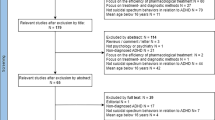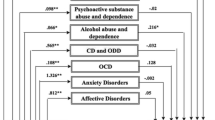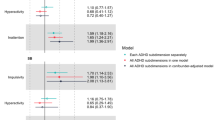Abstract
Objective
To investigate the prevalence and psychosocial correlates of suicidal behaviour in a representative sample of children and adolescents in Germany.
Methods
Suicidal behaviour was assessed in the BELLA study in a sample of 2,863 families with children aged 7–17 using the corresponding questions from the child behavior check list and the youth self report. Self-reported as well as parent-reported measures of overall mental health problems, anxiety, depression, aggressive and delinquent behaviour, attention deficit-/hyperactivity as well as health-related quality of life were also administered.
Results
Self-mutilation and/or suicidal attempts within the last six months were reported by 2.9% of the adolescents 11–17 years of age. Suicidal thoughts were reported by 3.8% of the same group of adolescents. The prevalence rates reported by the parents were 1.4% for self-mutilation and/or suicidal attempts and 2.2% for suicidal thoughts. The prevalence of parent-reported self-mutilation/suicidal attempts in children below 11 years of age was very low. Youth reporting suicidal behaviour were older than youth not reporting suicidal behaviour. Children and adolescents exhibiting suicidal behaviour reported significantly more general mental health problems, depressive symptoms, anxiety, and hyperactivity as well as lower health-related quality of life.
Conclusions
There is a strong connection between suicidal behaviour and emotional and behavioural problems, especially with symptoms of depression, anxiety and hyperactivity. The association observed between attention deficit-/hyperactivity and suicidal behaviour requires further investigation. The differences in the extent of reported suicidal behaviour in adolescents between the self- and parent-ratings and the degree of confidentiality in the collection of the data are subjects for future research.
Similar content being viewed by others
References
Arbeitsgruppe Deutsche Child Behavior Checklist (1998) Elternfragebogen über das Verhalten von Kindern und Jugendlichen; deutsche Bearbeitung der Child Behavior Checklist (CBCL/4-18). Arbeitsgruppe Kinder-, Jugend- und Familiendiagnostik, Köln
Bae S, Ye R, Chen S, Rivers PA, Singh KP (2005) Risky behaviors and factors associated with suicide attempt in adolescents. Arch Suicide Res 9:193–202
Birmaher B, Khetarpal S, Brent D, Cully M, Balach L, Kaufman J, Neer SM (1997) The screen for child anxiety related emotional disorders (SCARED): scale construction and psychometric characteristics. J Am Acad Child Adolesc Psychiatry 36:545–553
Bridge JA, Goldstein TR, Brent DA (2006) Adolescent suicide and suicidal behavior. J Child Psychol Psychiatry 47:372–394
Brunner R, Parzer P, Haffner J, Steen R, Roos J, Klett M, Resch F (2007) Prevalence and psychological correlates of occasional and repetitive deliberate self-harm in adolescents. Arch Pediatr Adolesc Med 161:641–649
Cohen J (1988) Statistical power analysis for the behavioral science. Lawrence Erlbaum Associates Publishers, Hillsdale
Conners K (1996) Conners’ rating scale–revised. Technical manual. Multi-Health Systems Inc., New York
Döpfner M, Lehmkuhl G (2000) Diagnostik-System für psychische Störungen im Kindes- und Jugendalter nach ICD-10 und DSM-IV (DISYPS-KJ). Huber, Bern
Evans E, Hawton K, Rodham K, Deeks J (2005) The prevalence of suicidal phenomena in adolescents: a systematic review of population-based studies. Suicide Life Threat Behav 35:239–250
Faulstich ME, Carey MP, Ruggiero L, Enyart P, Gresham F (1986) Assessment of depression in childhood and adolescence: an evaluation of the Center for Epidemiological Studies Depression Scale for Children (CES-DC). Am J Psychiatry 143:1024–1027
Flouri E (2005) Psychological and sociological aspects of parenting and their relation to suicidal behavior. Arch Suicide Res 9:373–383
Goodman R, Meltzer H, Bailey V (1998) The strengths and difficulties questionnaire: a pilot study on the validity of the self-report version. Eur Child Adolesc Psychiatry 7:125–130
Gould MS, Greenberg T, Velting DM, Shaffer D (2003) Youth suicide risk and preventive interventions: a review of the past 10 years. J Am Acad Child Adolesc Psychiatry 42:386–405
Hallfors DD, Waller MW, Ford CA, Halpern CT, Brodish PH, Iritani B (2004) Adolescent depression and suicide risk: association with sex and drug behavior. Am J Prev Med 27:224–231
Hawton K, Arensman E, Wasserman D, Hulten A, Bille-Brahe U, Bjerke T, Crepet P, Deisenhammer E, Kerkhof A, De Leo D, Michel K, Ostamo A, Philippe A, Querejeta I, Salander-Renberg E, Schmidtke A, Temesvary B (1998) Relation between attempted suicide and suicide rates among young people in Europe. J Epidemiol Community Health 52:191–194
Hawton K, Rodham K, Evans E, Weatherall R (2002) Deliberate self harm in adolescents: self report survey in schools in England. BMJ 325:1207–1211
Kamtsiuris P, Lange M, Schaffrath Rosario A (2007) Der Kinder- und Jugendgesundheitssurvey (KiGGS): Stichprobendesign, Response und Nonresponse-Analyse. Bundesgesundheitsbl Gesundheitsforsch Gesundheitsschutz 50:547–556
Levy PS, Lemeshow S (1999) Sampling of Populations. Wiley, New York
Portzky G, van Heeringen K (2006) Suicide prevention in adolescents: a controlled study of the effectiveness of a school-based psycho-educational program. J Child Psychol Psychiatry 47:910–918
Rao JNK, Scott AJ (1984) On chi-squared tests for multiway contingency tables with cell proportions estimated from survey data. Ann Stat 12:46–60
Ravens-Sieberer U, Gosch A, Rajmil L, Erhart M, Bruil J, Duer W, Auquier P, Power M, Abel T, Czemy L, Mazur J, Czimbalmos A, Tountas Y, Hagquist C, Kilroe J, European KIDSCREEN Group (2005) KIDSCREEN-52 quality-of-life measure for children and adolescents. Expert Rev Pharmacoecon Outcome Res 5:353–364
Ravens-Sieberer U, Wille N, Bettge S, Erhart M (2007) Psychische Gesundheit von Kindern und Jugendlichen in Deutschland. Bundesgesundheitsbl Gesundheitsforsch Gesundheitsschutz 50:871–878
Ravens-Sieberer U, Wille N, Erhart M, Bettge S, Wittchen H-U, Rothenberger A, Herpertz-Dahlmann B, Resch F, Hölling H, Bullinger M, Barkmann C, Schulte-Markwort M, Döpfner M as the BELLA study group (2008) Prevalence of mental health problems among children and adolescents in Germany: results of the BELLA study within the National Health Interview and Examination Survey. Eur Child Adolesc Psychiatry 17(Suppl1):22–33
Rothenberger A, Becker A, Erhart M, Wille N, Ravens-Sieberer U, BELLA study group (2008) Psychometric properties of the parent strengths and difficulties questionnaire in the general population of German children and adolescents: results of the BELLA study. Eur Child Adolesc Psychiatry 17(Suppl1): 99–105
StataCorp (2007) Stata Statistical Software: Release 10. StataCorp, College Station
Steele MM, Doey T (2007) Suicidal behaviour in children and adolescents. part 1: etiology and risk factors. Can J Psychiatry 52:21S–33S
Steinhausen HC, Bosiger R, Metzke CW (2006) Stability, correlates, and outcome of adolescent suicidal risk. J Child Psychol Psychiatry 47:713–722
Thompson EA, Mazza JJ, Herting JR, Randell BP, Eggert LL (2005) The mediating roles of anxiety depression, and hopelessness on adolescent suicidal behaviors. Suicide Life Threat Behav 35:14–34
Velez CN, Cohen P (1988) Suicidal beahavior and ideation in a community sample of children: maternal and youth reports. J Am Acad Child Adolesc Psychiatry 27:349–356
Wille N, Bettge S, Ravens-Sieberer U, BELLA study group (2008) Risk and protective factors for children’s and adolescents’ mental health: results of the BELLA study. Eur Child Adolesc Psychiatry 17(Suppl1):133–147
Conflict of interest
All authors declare no conflict of interest.
Author information
Authors and Affiliations
Consortia
Corresponding author
Additional information
Members of the BELLA study group: Ulrike Ravens-Sieberer (Principal Investigator), Claus Barkmann, Susanne Bettge, Monika Bullinger, Manfred Döpfner, Michael Erhart, Beate Herpertz-Dahlmann, Heike Hölling, Franz Resch, Aribert Rothenberger, Michael Schulte-Markwort, Nora Wille, Hans-Ulrich Wittchen.
Rights and permissions
About this article
Cite this article
Resch, F., Parzer, P., Brunner, R. et al. Self-mutilation and suicidal behaviour in children and adolescents: prevalence and psychosocial correlates: results of the BELLA study. Eur Child Adolesc Psychiatry 17 (Suppl 1), 92–98 (2008). https://doi.org/10.1007/s00787-008-1010-3
Published:
Issue Date:
DOI: https://doi.org/10.1007/s00787-008-1010-3




